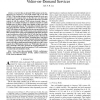Free Online Productivity Tools
i2Speak
i2Symbol
i2OCR
iTex2Img
iWeb2Print
iWeb2Shot
i2Type
iPdf2Split
iPdf2Merge
i2Bopomofo
i2Arabic
i2Style
i2Image
i2PDF
iLatex2Rtf
Sci2ools
TMM
2002
2002
On a unified architecture for video-on-demand services
Abstract--Current video-on-demand (VoD) systems can be classified into two categories: 1) true-VoD (TVoD) and 2) near-VoD (NVoD). TVoD systems allocate a dedicated channel for every user to achieve short response times so that the user can select what video to play, when to play it, and perform interactive VCR-like controls at will. By contrast, NVoD systems transmit videos repeatedly over multiple broadcast or multicast channels to enable multiple users to share a single video channel so that system cost can be substantially reduced. The tradeoffs are limited video selections, fixed playback schedule, and limited or no interactive control. TVoD systems can be considered as one extreme where service quality is maximized, while NVoD systems can be considered as the other extreme where system cost is minimized. This paper proposes a novel architecture called Unified VoD (UVoD) that can be configured to achieve cost-performance tradeoff anywhere between the two extremes (i.e., TVoD and NV...
| Added | 23 Dec 2010 |
| Updated | 23 Dec 2010 |
| Type | Journal |
| Year | 2002 |
| Where | TMM |
| Authors | Jack Y. B. Lee |
Comments (0)

